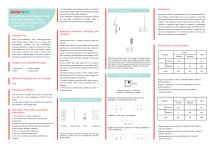
- Laboratory
- Laboratory medicine
- Rapid infectious disease test
- Hangzhou Antigenne Technology Co. Ltd
- Company
- Products
- Catalogs
- News & Trends
- Exhibitions
Rapid infectious disease test Sabervetveterinaryfor canineslead
Add to favorites
Compare this product
fo_shop_gate_exact_title
Characteristics
- Applications
- for infectious diseases
- Application field
- veterinary
- Patient type
- for canines
- Tested parameter
- lead
- Sample type
- blood, clinical
- Format
- cassette
Description
Fimbriosis, also known as anaplasmosis, is an infectious blood parasite transmitted by marginal anaplasmosis via ticks that exclusively parasitises red blood cells. It mainly causes disease in ruminants, horses, humans, dogs and cats.
Clinical signs of Anaplasma canis
Infection with Anaplasma is generally chronic, the beginning does not show obvious clinical symptoms when the resistance drops, high fever, anaemia, gangrene and progressive wasting and other symptoms, acute onset of the disease can lead to animal death. In addition, the severity of clinical symptoms after canine anaplasmosis infection may also be related to the different strains of anaplasmosis, and the haematological examination of the animals suffering from siderophagy shows a significant decrease in the number of erythrocytes, the erythrocyte pressure volume and the haemoglobin content.
Route of transmission
Anaplasma is transmitted primarily by hard ticks; other vectors also include a variety of blood-sucking insects such as gadflies, flies and mosquitoes. Anaplasma is transmitted by biting a host animal that carries the pathogen and then biting other healthy animals. In addition, free-range farming practices can increase the risk of infection between animals, and the onset of Anaplasma occurs during the active season for ticks and bloodsucking insects, with the peak of transmission occurring in August-October.
Exhibitions
Meet this supplier at the following exhibition(s):

Other Hangzhou Antigenne Technology Co. Ltd products
Canine
Related Searches
- Blood rapid diagnostic test
- Rapid lateral flow test
- Immunoassay rapid diagnostic test
- Cassette rapid diagnostic test
- Virus rapid diagnostic test
- Serum rapid diagnostic test
- Plasma rapid diagnostic test
- Infectious disease rapid diagnostic test
- Whole blood rapid diagnostic test
- Rapid respiratory infection test
- Urine rapid screening test
- Bacteria rapid diagnostic test
- Rapid feces test
- Clinical rapid diagnostic test
- Nasal rapid diagnostic test
- Obstetrical/gynecological rapid test
- Rapid oral flu test
- Dog rapid test
- Coronavirus rapid diagnostic test
- Laboratory rapid diagnostic test
*Prices are pre-tax. They exclude delivery charges and customs duties and do not include additional charges for installation or activation options. Prices are indicative only and may vary by country, with changes to the cost of raw materials and exchange rates.








































